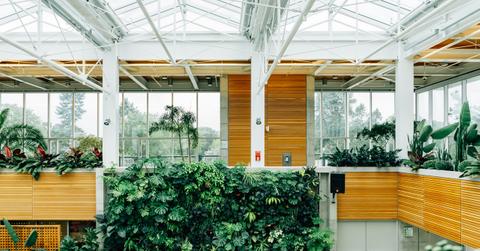Geothermal Greenhouse Lets You Grow Sustainable Crops In The Cold
Greenhouses provide a great way to for the Midwest to grow crops during bitter cold weather, but they can take a lot of energy to maintain. Russ Finch has developed a greenhouse that uses the Earth's internal heat to significantly cut energy usage.
Updated May 17 2019, 8:55 p.m. ET
In the Midwest, everything moves indoors during the winter growing season. Farmers markets in bigger cities are transferred from major roads to inside community buildings, and crops are raised in greenhouses that generally use a lot of fossil fuels. However, green energy sources could provide a more sustainable way to raise fruits and vegetables, and a former mailman from Nebraska has been able to achieve that using geothermal heating.
Russ Finch is part of the group that’s built a “Greenhouse in the Snow.” Starting in Nebraska 20 years ago, the community has now spawned 17 of them across six different states in America and in Canada. The very first greenhouse is attached to Finch’s home, and his initial goal was to grow a variety of produce without the need of extra electricity.
To accomplish this task, Finch decided to use internal heat from the Earth to mostly power the greenhouse. This process is done by planting a perforated plastic tube and loops it from one end of the greenhouse to the other. A fan is used to move heat through these tubes. Even when the temperatures are close to zero degrees outside in the winter, this warmth kept the greenhouse at least above 28 degrees.
No doctoring was used in order to help plants grow, and the results were mostly positive. "Any type of plant we saw, we would put it in and see what it could do. We didn't baby anything," Finch told NPR. "We just put it in and if it died, it died. But most everything really grows well. We can grow practically any tropical plant."
Even better: It costs just $1 a day for this process. That’s a pretty low cost considering it’s able to help him grow hundreds of pounds of fruit annually. Instead of shipping fruit around the world -- which sometimes was a cheaper method than traditional greenhouses -- Finch keeps things local. That’s sparked more of these geothermal greenhouses to be built.
During the winter months, water is also scarcely used. This is because humidity doesn’t escape the facility and that moisture helps those crops thrive. Any energy that’s used is for the fan that helps blow that warm air through the tubes and circulates it through the greenhouse. Over the course of the year, temperatures can range from 95 degrees to 33 degrees according to Finch.
It’s a similar process to the walipini greenhouses, which were also an alternative to grow crops in colder climates. Walipini means “place of warmth,” and these underground plantations were first developed in South America’s cooler areas. All it takes is around $300 to set one of these up. That’s much cheaper than geothermal greenhouse, which takes about $22,000 to create, but the latter is on a much bigger scale.
Greenhouses provide a great way for areas that don’t have the luxury of great weather all year long to continue growing crops and eating locally. Finch has provided a blueprint for a “greener” greenhouse and the new process is continuing to expand.
